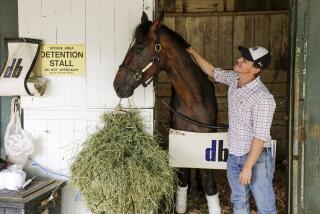FBI Racehorse in Track Probe Is Identified
- Share via
BUFFALO, N.Y. — The Boston Herald today identified the “undercover horse” used in an FBI sting operation as Zachregard, a 5-year-old mare that is still running at Finger Lakes Race Track.
The horse, whose success surprised federal agents, is entered in the ninth race, a $3,000 claimer, this afternoon, according to track spokesman John Kolomic
Dale Anderson, senior resident agent at the FBI’s Rochester bureau, said he was “unable to make any comment one way or another” on the report because “there is an ongoing investigation.”
FBI agents looking into race-fixing at Finger Lakes said they chose the thoroughbred for their undercover operation because of its unimpressive record.
But the horse, which officials had hoped would draw out would-be race fixers, gave agents more than they expected and proved too good to attract the interest of the investigation’s targets.
“We thought he was just an aging old race horse and actually it turned out that it was pretty good,” said G. Robert Langford, special agent in charge of the FBI’s Buffalo office.
Langford on Tuesday provided some details into a 1989 undercover operation at a track in Canandaigua, 80 miles east of Buffalo, that led to race-fixing charges against a jockey, two trainers and the former wife of one of the trainers.
Langford characterized the investigation as the first successful use of a horse in an undercover race track operation by the FBI.
The horse surprised government officials by winning at least one race and finishing in the money in about half of the races it ran in, Langford said.
“When we started winning, it kind of got us a little nervous,” Langford said.
The horse was selected for the sting because it appeared to be a mediocre horse that wasn’t capable of dominating the competition, he said.
“You need an average horse that doesn’t stand out,” he said. If a horse that has been successful suddenly starts losing, “it rings a lot of bells” with track observers looking for the fix.
“When a horse wins all the time, not many people want to try to fix the race with it,” he said.
The horse performed so well it didn’t draw out would-be race fixers, Langford said. The case against the four suspects instead was developed by a combination of observations of the Sept. 26, 1989, race in question and by conversations overheard by the agent-trainer, he said.
More to Read
Go beyond the scoreboard
Get the latest on L.A.'s teams in the daily Sports Report newsletter.
You may occasionally receive promotional content from the Los Angeles Times.










